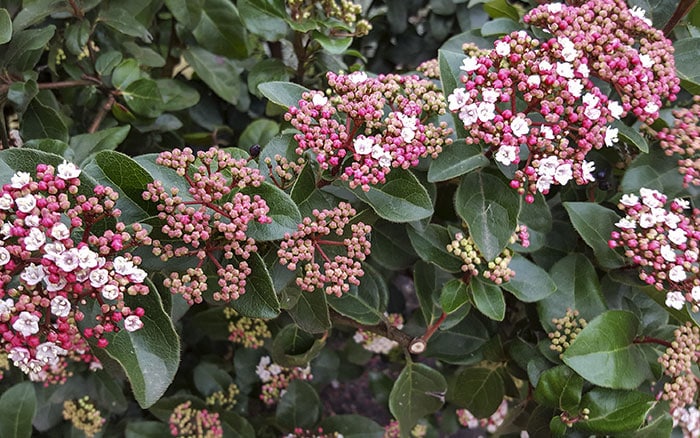There is a lot to love about viburnum! Easy to grow, and undemanding shrubs that can benefit wildlife as well as look attractive.
There’s a great and varied choice. Some are evergreen; others deciduous. Many produce scented flowers and coloured berries, and grow to different heights, which means there is a viburnum to suit almost every gardener and their garden.
How to look after me

Care
Aesthetic
What to be wary of
Viburnums need soil to be regularly moist but not waterlogged, so make sure they’re regularly watered during periods of drought. Ensure that the soil remains free-draining during periods of extreme wet weather.
Although most viburnums are tough, some can be affected by Viburnum beetle, scale, and aphids. But happily, these don’t generally adversely affect the shrub too much.
All viburnums are, however, susceptible to honey fungus that can attack and kill the roots. The only known way currently to deal with an outbreak is to dig out the affected plant(s) and take it to a local recycling centre.
But you can prevent it from spreading. Try burying a strip of thick plastic or pond lining 45cm deep, vertically, finishing about 2-3cm above soil level, as this can be very effective.
Their hardiness varies quite a bit depending on which variety you have, so ensure to double-check so that you know the best way to look after it once the cold weather approaches.
Evergreens
They are tough shrubs that don’t mind exposed sites, and will grow well in all aspects and soil types, but avoid north facing.
Regular pruning isn’t required, but if you need to it’s best done during the winter or spring months immediately after flowering finishes.
Most will reach up to 250 cm, and will ultimately grow to a similar width.

Popular Varieties
Viburnum tinus ‘Eve Price’
This variety is one of the most commonly available viburnum, which grows into fairly dense, bushy, medium-sized shrub.
It produces delightful pinky-white flower clusters during the winter months which are then followed by blue-black coloured berries.
Viburnum tinus ‘French White’
This is a similar looking cultivar to ‘Eve Price’ which produces pure white flowers in late winter into spring.
Viburnum davidii
If you’re looking for a lower growing shrub with architectural leaves that provides good ground cover, then Viburnum davidii is a great choice.
It will ultimately reach a height and width of up to 150cm, growing in sun or part shade, and any aspect or soil type!
Viburnum rhytidophyllum
If you’ve space for a much larger shrub, Viburnum rhytidophyllum develops a wonderful, contorted branch structure as it ages.
It reaches a height and width of 400cm, and again will grow in any situation.
Deciduous
Viburnums that lose their leaves over winter more than make up for their bare stems by producing either delightfully scented flowers over winter and into spring, autumn berries and/or a wonderful autumn leaf colour.
Varieties
Viburnum opulus
This variety delights with frothy, white flowers in early summer.
This is followed by a stunning autumn leaf colour and bright red berries, which are great for the birds to feed on as winter approaches.


Viburnum plicatum f. tomentosum ‘Mariesii’
This is a stunner.
Its branches naturally grow horizontally in tiers, and it produces large, lace cap, white flowers in late spring.
It may be a mouthful to say, but you need only ask the plant nursery or garden centre for ‘Viburnum Mariessi’ and they will know exactly what you want.
Scent
The flowers of viburnum can create a beautiful scent regardless of whether they are deciduous or evergreen, and their fragrances lean towards sweet when they flower.
Varieties
V. x bodnantese ‘Dawn’
This variety produces clusters of delightfully scented light pink to white flower clusters from autumn right the way through to spring.
If you’ve inherited an overgrown ‘Dawn’, the good news is that it can be pruned very hard in spring after its finished flowering.
Don’t worry if harsh weather conditions spoil the flowers, they will soon be followed by new ones.
V. x. carlcephalum (fragrant snowball)
This viburnum flowers in late spring.
The flowers are large, round, pinky-white and beautifully scented.
It grows to a height of about 250cm and the leaves have a gorgeous colour in autumn.
V. x. burkwoodii (Burkwood viburnum)
This variety is ideal if you’d prefer an scented evergreen variety.
Burkwood viburnum grows to a similar height as carlcephalum, and flowers at a similar time, but has glassy dark evergreen leaves.

Top Tip
Smaller scented varieties are ideal to grow in patio containers!

Leave A Comment